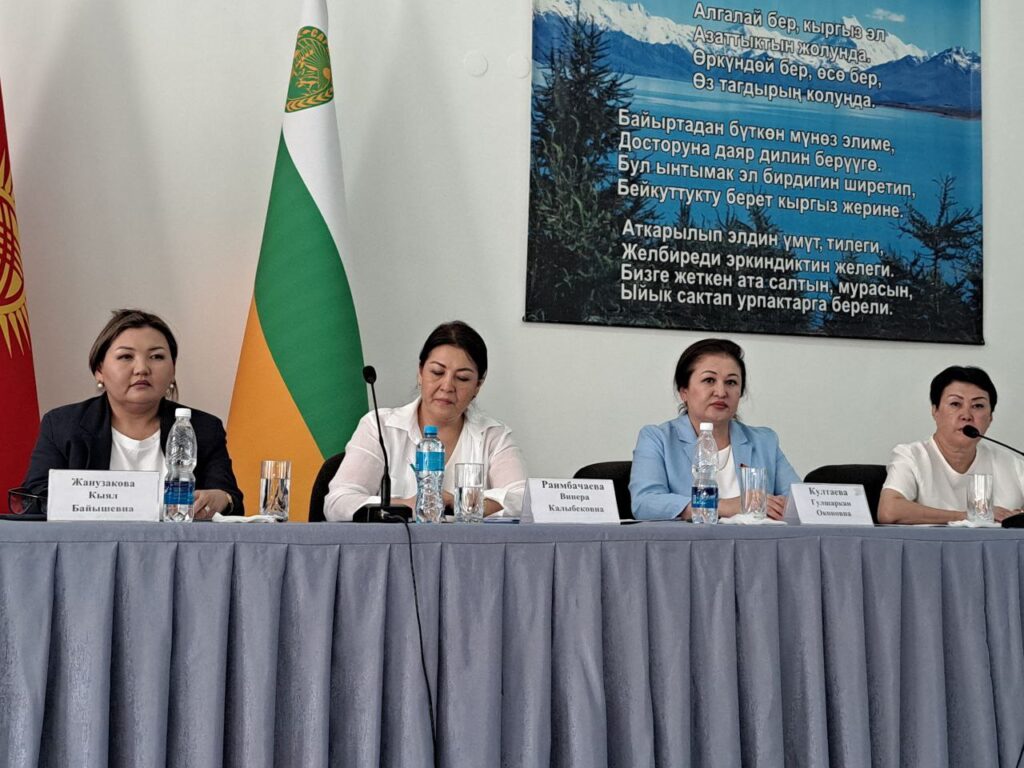On August 14, a regional roundtable on the topic “How to strengthen women’s political participation and leadership in Kyrgyzstan?” was held at the Issyk-Ata District State Administration.
The main goal of the meeting, initiated by the Chairperson of the Committee on Social Policy, Venera Raimbachaeva, was to discuss proposals and recommendations for improving the legislation of the Kyrgyz Republic regarding women’s representation in decision-making processes.
During her speech, Deputy Venera Raimbachaeva emphasized that the Kyrgyz Republic faces the task of actively promoting women’s leadership, implementing mechanisms that facilitate broader participation of women in decision-making and increasing their representation in leadership positions in public administration. The parliamentarian also highlighted the importance of implementing the Kyrgyz Republic’s State Program for Supporting Women’s Leadership until 2030 in achieving the set goals.

In order to ensure equal rights and opportunities for women in the political and public life of the country, as well as to ensure their equal access to resources and participation in decision-making at all levels of public administration, the Decree of the President of the Kyrgyz Republic dated March 7, 2024 (Decree No. 62) approved the State Program for Supporting Women’s Leadership until 2030. The program includes a budget, an Action Plan for 2024-2027, and an indicator matrix for monitoring and evaluating its implementation.
The State Program was developed to define strategically important initiatives aimed at increasing the representation and active participation of women in the political, public, and economic life of the country. Women’s participation in decision-making and their leadership are integral components of ensuring fair and equal development of society. Throughout the history of Kyrgyzstan, women have played an important role in its progress and prosperity. However, despite the achievements, the potential of women in politics and other areas remains insufficiently recognized and utilized.
Today, the Kyrgyz Republic faces the task of actively promoting women’s leadership, implementing mechanisms that facilitate broader participation of women in decision-making and increasing their representation in leadership positions in public administration. The program is focused on creating a fair and modern system where gender equality and women’s leadership will be solid foundations for the development and success of the state and society.

Deputy Venera Raimbachaeva, speaking at the event, noted that the Kyrgyz Republic faces the task of actively promoting women’s leadership, implementing mechanisms that facilitate broader participation of women in decision-making and increasing their representation in leadership positions in public administration. The parliamentarian also emphasized the importance of implementing the State Program of the Kyrgyz Republic for supporting women’s leadership until 2030 to achieve the set goals.
In her speech, Deputy Gulsharkan Kultaeva highlighted the importance of cooperation between government bodies and civil society in promoting women’s leadership and expanding their participation in political decision-making.
The regional roundtable became an important platform for strengthening interaction between members of the Jogorku Kenesh, representatives of the Ministry of Labor, Social Security, and Migration of the Kyrgyz Republic, the Central Election Commission of the Kyrgyz Republic, the State Personnel Service of the Kyrgyz Republic, the Presidential Plenipotentiary Representative in the Chui region, the district state administration, and women leaders of the Sokuluk district. The main goal of the meeting was to discuss proposals and recommendations for improving the legislation of the Kyrgyz Republic regarding women’s representation at the decision-making level.

